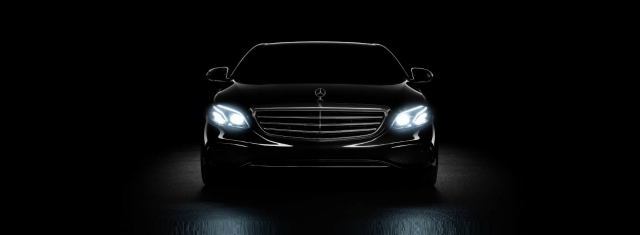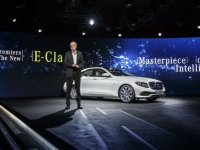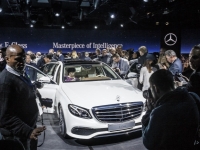Automobiles
130 years of the automobile
1886 to 2016

Mercedes-Benz E-Class 2016 (Source: © 2016 Daimler AG. All rights reserved. )
USPA NEWS -
1886 to 2016: from the Benz Patent Motor Car to the semi-autonomous new E-Class: 130 years of the automobile: Mercedes-Benz launches a further revolution in mobility in Detroit. The inventor of the automobile is presenting the most advanced production vehicle in the world, the new E-Class.
On 29 January 1886 Carl Benz applied to the Imperial Patent Office in Berlin for the most significant patent of the industrial age: a "motorised vehicle powered by a gas engine" - the initial idea behind all further automobile designs in the century that followed. 130 years later, on 11 January 2016, Mercedes-Benz is in "Motown" Detroit to show the new E-Class, the car with the technological capability to revolutionise mobility all over again.
As the inventor of the automobile, Mercedes-Benz continues to press forward with the development of mobility in all areas. The company's expertise at both a technical and a conceptual level is underscored by more than 90,000 registered patents, together with a long list of innovations that were first introduced to the market in models from Mercedes ““ these range from engines to safety, comfort and design features. The absolute state of the art of automotive development in all these areas is reflected by the new E-Class.
Just two examples: the innovative plug-in hybrid drive system, coupled with lightweight construction techniques and superb aerodynamic performance, sets new standards for efficiency. The similarly new multi-chamber air suspension is an option that ensures outstanding ride comfort. The tremendous scope of the E“‘Class's innovative features, which include among them the Active Lane-change Assistant that steers the saloon as if by magic into the lane selected by the driver, makes it the most intelligent saloon in the business class.
It is this intelligence that also makes the new E-Class a milestone on the way to the self-driving automobile - for Mercedes-Benz and for the automotive industry as a whole. The latest evidence of this special status was provided just a few days ago, when the authorities in the US state of Nevada gave their approval to allow the testing of autonomous driving with the new E-Class ““ not with a prototype, but with a production vehicle. Mercedes-Benz was the first motor manufacturer in the world to receive the relevant licence during this year's International Consumer Electronics Show (CES).
The processing power of the car's high-tech electrical/electronic systems and its IT infrastructure, together with its sensors, allow a level of mobile autonomy hitherto unmatched in series production: the driver only needs to steer ““ assuming they wish to do so - on a temporary basis. The traffic lane and speed are regulated, while the vehicle reacts to speed limits and to the traffic around it.
The E-Class as the next stage of automotive evolution -
The new Mercedes-Benz E-Class thus marks the beginning of a new phase in automotive development: "For Mercedes, as the inventor of the automobile, it was always clear that the next great revolution in mobility would be the self-driving car", notes Dr Dieter Zetsche, Chairman of the Board of Management of Daimler AG and Head of Mercedes-Benz Cars.
The new Mercedes-Benz E-Class thus marks the beginning of a new phase in automotive development: "For Mercedes, as the inventor of the automobile, it was always clear that the next great revolution in mobility would be the self-driving car", notes Dr Dieter Zetsche, Chairman of the Board of Management of Daimler AG and Head of Mercedes-Benz Cars.
At the Consumer Electronics Show 2015 in Las Vegas, which saw the world premiere of the fully autonomous Mercedes-Benz F 015 Luxury in Motion research vehicle, Dr Zetsche was already talking about this role for the automobile of the future: "People have been dreaming of self-driving cars since the 1950s. We at Mercedes were the ones who once turned the vision of mobility without a horse into reality. Now it's time for us to offer the possibility of managing without a driver as well."
Building the technological bridge to freedom -
As the Head of Group Research at Daimler, Anke Kleinschmit sees this technological avant-garde as part of a cultural tradition: "At the time of its invention, the groundbreaking innovation of the automobile brought about what could perhaps be described as a space warp. Suddenly distances contracted and people came closer together. Fast, individual transport provided a technological bridge between two worlds that until then had lain so very far apart."
As the Head of Group Research at Daimler, Anke Kleinschmit sees this technological avant-garde as part of a cultural tradition: "At the time of its invention, the groundbreaking innovation of the automobile brought about what could perhaps be described as a space warp. Suddenly distances contracted and people came closer together. Fast, individual transport provided a technological bridge between two worlds that until then had lain so very far apart."
This bridge was to prove extremely successful: since its invention, the automobile has developed into one of the world's most important economic factors, with more than 50 million people working in countless companies carrying forward the legacy of Carl Benz and Gottlieb Daimler. The desire for individual transport is still a strong selling point today, when so many people rely on the car for personal freedom.
Self-driving vehicles in the 21st century -
But while in the 20th century this freedom was above all the freedom to travel and get around, today's cars allow a different sort of freedom. As Dr Zetsche describes it: "Cars have become mobile homes, in the truest sense of the words. Protected spaces, as it were, where people can pursue their dreams and fulfil their individual needs." Daimler's Board Chairman sees the autonomous vehicle as holding a key role in this respect: "This technology will give every occupant of a vehicle completely new opportunities to make use of valuable time."
But while in the 20th century this freedom was above all the freedom to travel and get around, today's cars allow a different sort of freedom. As Dr Zetsche describes it: "Cars have become mobile homes, in the truest sense of the words. Protected spaces, as it were, where people can pursue their dreams and fulfil their individual needs." Daimler's Board Chairman sees the autonomous vehicle as holding a key role in this respect: "This technology will give every occupant of a vehicle completely new opportunities to make use of valuable time."
With the new E-Class now going into production, Mercedes-Benz is able to look back on a thirty-year tradition of technology for self-driving cars. Although the first experimental vehicles with autonomous mobility functionality formed part of the Prometheus project as far back as the late 1980s, the pace of development has been stepped up in recent years: in August 2013, the so-called "Bertha Benz Drive" saw an autonomous S-Class follow the historic route of the first journey ever in an automobile.
Two years later Mercedes-Benz presented the F 015 Luxury in Motion, a design study for the car of the future, in Las Vegas. And just a few months after that, the Governor of Nevada issued the first official licence plate for an autonomously driving truck: the Inspiration Truck of Daimler subsidiary Freightliner has been operating its freight routes ever since as the first goods vehicle with autonomous technology on board.
The automobile of the future -
The new E-Class now transfers this technology to a standard-production passenger car, so securing mobile autonomy as an established part of everyday life. This model series enjoys particular popularity as a business saloon and, over the decades since it was first introduced, has built up its standing as the mainstay of the company. For Professor Dr Thomas Weber, Member of the Board of Management of Daimler AG, responsible for Group Research and Mercedes-Benz Cars Development, this makes the new E-Class the right model to take up this trend:
The new E-Class now transfers this technology to a standard-production passenger car, so securing mobile autonomy as an established part of everyday life. This model series enjoys particular popularity as a business saloon and, over the decades since it was first introduced, has built up its standing as the mainstay of the company. For Professor Dr Thomas Weber, Member of the Board of Management of Daimler AG, responsible for Group Research and Mercedes-Benz Cars Development, this makes the new E-Class the right model to take up this trend:
"We are taking a further major step on the way to autonomous and networked driving. The innovations found in the new E-Class define a new benchmark in terms of safety, stress relief, comfort and networked living, so allowing Mercedes-Benz once again to underline its leadership position."
In this, the 130th year since Benz invented the car, there is one thing about which Dr Dieter Zetsche is certain: "The best is still to come for the car sporting the three-pointed star. The Mercedes of the future will drive not only with zero emissions, but autonomously, too. It will be even safer, more luxurious & fully networked as well. A comfortable retreat for the journey between office and home ““ a place to work, communicate, relax and enjoy."
In this, the 130th year since Benz invented the car, there is one thing about which Dr Dieter Zetsche is certain: "The best is still to come for the car sporting the three-pointed star. The Mercedes of the future will drive not only with zero emissions, but autonomously, too. It will be even safer, more luxurious & fully networked as well. A comfortable retreat for the journey between office and home ““ a place to work, communicate, relax and enjoy."
Liability for this article lies with the author, who also holds the copyright. Editorial content from USPA may be quoted on other websites as long as the quote comprises no more than 5% of the entire text, is marked as such and the source is named (via hyperlink).











